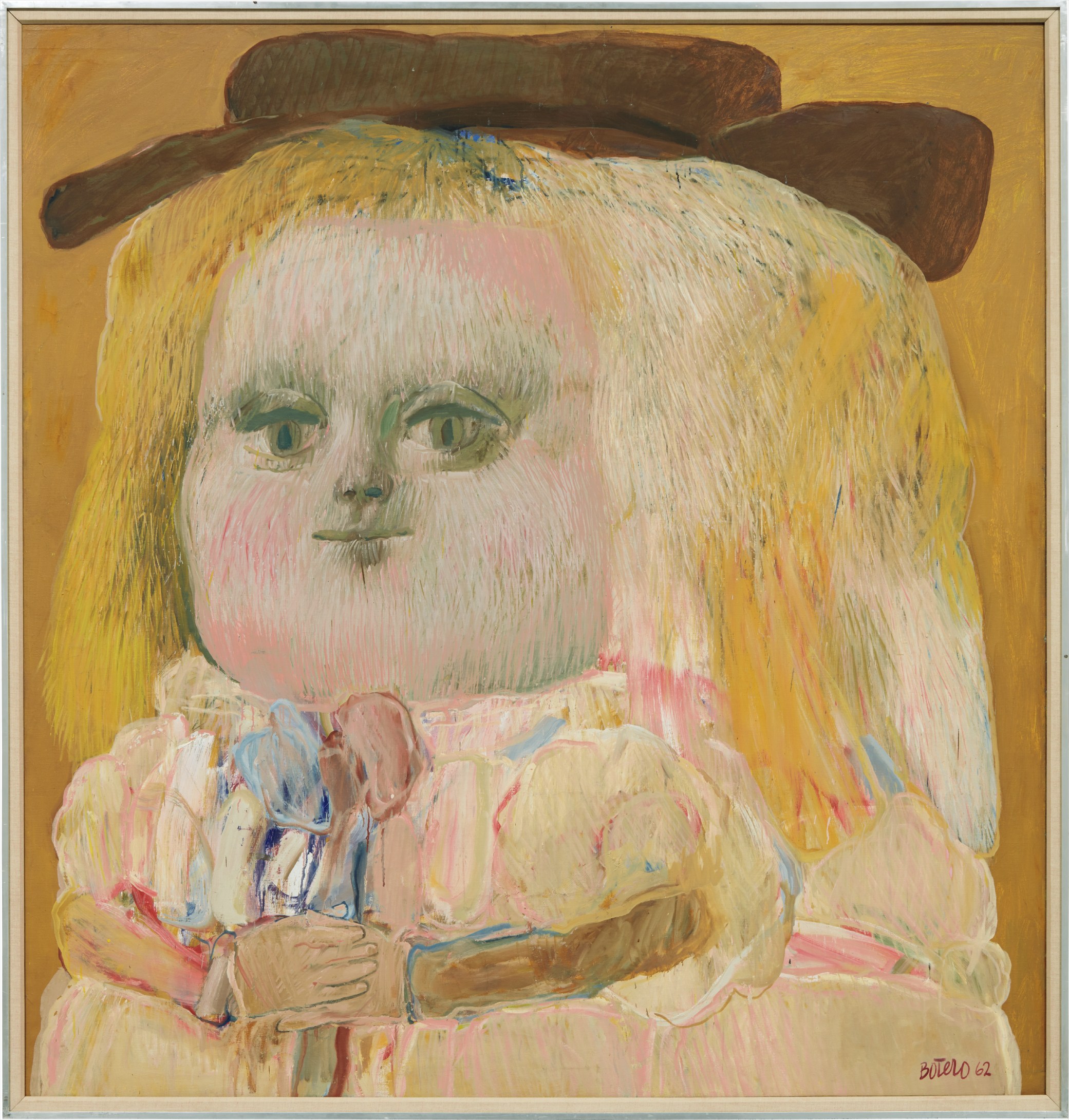



36
Fernando Botero
Yellow Niña
Full-Cataloguing
Yellow Niña articulates the approach of “post-abstract portraiture” that Botero began to develop in his early career, which, as he explains, “means that sometimes the space is used subjectively, over and above any respect for proportions. The monumentality of the figures and elements that compose my paintings does not follow the rules of perspectives, but simply helps me to create a general harmony…I am entirely unfettered in my use of form and color. In this sense, my vision is an abstract one” (Fernando Botero, quoted in Botero, Paintings 1959-2015, Turin, 2015, p. 37). While Botero’s encounter with the Mexican intelligentsia gave him the idea of exploring volume in his figures, it was only upon moving to New York in 1960 that he seriously began a thorough investigation of volume and form. In this period Botero came into direct contact with the representatives of Abstract Expressionism, particularly Willem de Kooning and Mark Rothko, and began to adopt the short, gestural brushstrokes evocative of the New York School. While immersed in an art world context dominated by abstract painting, Botero pursued his interest in the sensuality of form and sculptural voluminosity in the realm of figuration - painting his first portraits of overblown figures in homage to Leonardo da Vinci and Diego Velázquez.
By the time Botero created Yellow Niña in 1962, at age 30, this distinct style of figurative painting had gained him critical attention: he had been included in the Venice Biennial and the Guggenheim International Award exhibition and gained institutional recognition through the Museum of Modern Art’s acquisition of Mona Lisa, Age Twelve, 1959, in 1961. Firmly positioned within the artist’s great pantheon of paintings, the present work clearly demonstrates the artist’s career-long fascination with the human figure. Specifically demonstrating Botero’s career long admiration for Velázquez, whose work he intensely studied as a young artist at the Museo del Prado in Madrid, Yellow Niña articulates how the artist pursued a highly idiosyncratic approach to portraiture. “For Botero, art history is a huge, almost infinite warehouse of images, which can be raided but never copied”, Rudy Chiappini observed, “In fact, in his own way, he recreates it, giving life to images which demand their own independence. We are presented with real and true re-interpretations, in which the artists seeks to pay homage to famous paintings, albeit with a certain benevolent irony, attempting, at a distance of centuries, to recreate the spirit of the works, actualized and made real through his original idea of volumes and space, signs and colors” (Rudy Chiappini, ‘The Vision of the World in the a Fullness of Form’, Botero, Paintings 1959-2015, Turin, 2015, pp. 19-20).
In many ways, Botero follows in the conceptual footsteps of his great artistic hero Pablo Picasso, whose most brilliant work in the 1950s came as a result of carefully studying, dissecting and re-interpreting masterpieces by other painters. “If someone set out to copy Las Meninas “, Picasso proclaimed, “I would try to do it in my way, forgetting Velázquez… So, little by little, I would paint my Meninas which would appear detestable to the professional copyist; they wouldn’t be the ones he would believe he had seen in Velázquez’s canvas, but they would be ‘my’ Meninas” (Pablo Picasso, quoted in Museu Picasso Guide, Barcelona, 1998, p. 94). It is this spirit that Botero has pursued in his own homage to Velázquez with Yellow Niña. As with his greatest works, this monumental painting thereby visually articulates, how, in the artist’s own words, “all great painters achieve greatness through portraiture” (Fernando Botero, quoted in Botero, Paintings 1959-2015, Turin, 2015, p. 36).
Fernando Botero
Colombian | 1932Colombian artist Fernando Botero is known for his voluptuous and exaggerated paintings, sculptures and drawings. He studied under Roberto Longhi, a renowned authority on Italian Renaissance and Baroque art, obtaining a remarkable art historical knowledge of Western Classicism. This dialogue between an erudite education and religious art for the masses is the key in the development of his aesthetic.
Botero was also influenced by Mexican muralism, with which he became acquainted while living in Mexico City. The monumental scale of the human forms in the murals gave rise to the voluminous figures for which he is best known. Botero's works make mordant comments on society's shortcomings; they also incorporate classical elements and are imbued with political satire and caricature.